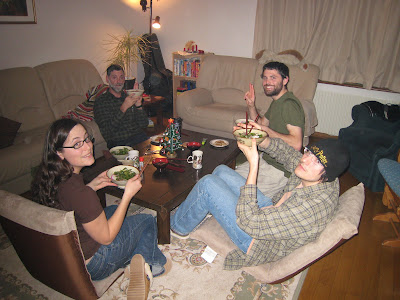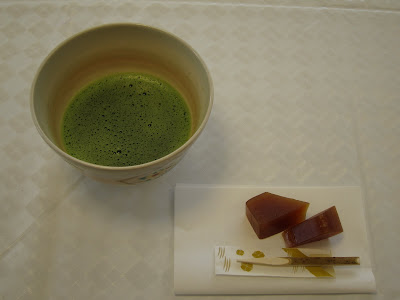This is the soup I invented in Japan for OMF's student ministry, fmZERO's "Olympics Party." This party was the brainchild of myself, Keith, and Tre. We spent 3 1/2 years in Vancouver (and we'll return there in April), and Tre was born in Toronto, so we were all keen to have an opportunity to celebrate Canada and Vancouver and the Olympics with our friends. We didn't really end up talking about Canada all that much, but that's fitting, because Canada wouldn't want to put itself forward. ;) First some party pictures. Keith was in charge of the party games.
Mop hockey
Some people got really into the games...
Yuki got a bit too excited during "sock speed skating" and ended up on the (newly waxed) floor. Meanwhile, I was in the kitchen finishing the soup.
No definite winner this round... so things were decided with a match of jankenpon.
We were thinking about food for the party, and we thought it should probably be Canadian. But what's Canadian food? Most people think of BC salmon and maple syrup. Salmon is kind of out of the question (too expensive, and not really unique, since the salmon here is just as good), and Maple Syrup… really expensive and hard to get. Well, we tried, but the store selling it was closed the day I tried to buy it. Oh well, I saved 2500 yen (about $27) by making "missionary maple syrup" to eat with our pancakes, which, incidentally, are served for dessert in Japan. More on that later.
"I think it's more British than Canadian," I mused to my Irish friend (John). "No," he said, smelling it, "definitely more continental." I pointed to the Italian herb mix and cooking wine, and he nodded. My English friend (Alaric) agreed that it was quite French given the presence of aubergine, and it would also be excellent with lamb. Thus some possible variations: maybe next time I'll use beer instead of wine, and more parsley. Then the next time, maybe lamb and lentils. Who knows?
Oh yeah… we are now known as the king and queen of cheap food. This was the cheapest party meal for an fmZERO party ever! For the most part, we used seasonal produce, and we have a great source of cheap onions and potatoes from a farm near our church.
Vancouver Olympics Beef Stew
Ingredients:
- Olive oil
- 5 small onions, diced
- 6 cloves garlic, minced
- 1/2 leek (or less, if you are not using the smallish Japanese variety), minced
- 1 stalk celery, diced
- Oregano or Italian herb mix
- a dash of cayenne pepper, if you like it spicy
- 200 g stewing beef, diced (we used chuck roast)
- 1 400 ml can peeled whole tomatoes and their juice, roughly diced
- 2 cups beef broth (I used "Better than Bouillon" and used it to rinse out the tomato can)
- 1/2 c red wine
- Some kind of grain: barley would have been great, but I used the Japanese seed and been mixture which people add to rice to increase the nutritional value. I think I put in about 3 Tbsp.
- 1 bay leaf
- 2 carrots, peeled and cut into large chunks
- 4 potatoes, peeled and cut into large chunks
- 6 mushrooms, quartered (I used shiitake, since they're the cheapest here; use your favourite kind.)
- 1 Japanese eggplant, quartered lengthwise and cut into bite-size pieces, then soaked in salt water for 20 minutes (optional)
- Salt and pepper to taste
- Tomato paste, if you like it thicker, although it should already be fairly thick
- 125 g frozen peas or green beans (cut into 2 cm segments)
- 2 Tbsp minced parsley
- To serve: rice or bread
Directions:
In a frying pan, warm the olive oil. Sauté the onions over low heat until they are caramelized (about 20 minutes). Add garlic, onions, and leek, and sauté for a few minutes. Add oregano or Italian herb mix and cayenne (optional) and cook for another minute.
Meanwhile, brown the beef in a large, heavy-bottom soup pot. Add the tomatoes, beef broth, wine, grain of choice, and bay leaf. Add the onion mixture when it's ready and deglaze the pan with a little water or broth.
Add the carrots, potatoes, and mushrooms to the soup as you finish chopping them. Bring the soup to a boil, reduce heat, and simmer at least until the potatoes and carrots are tender, about 45 minutes.
When the vegetables are tender, add the eggplant and simmer for another 30 minutes.
Season to taste with salt and pepper, and thicken with tomato paste if necessary, in particular if you will be serving the stew over rice. Right before serving, add the frozen peas or beans and parsley.
Serve over rice or with bread.
Serves 6-8
Enjoy the soup! Photo credits to Tre... thanks a lot!

















































